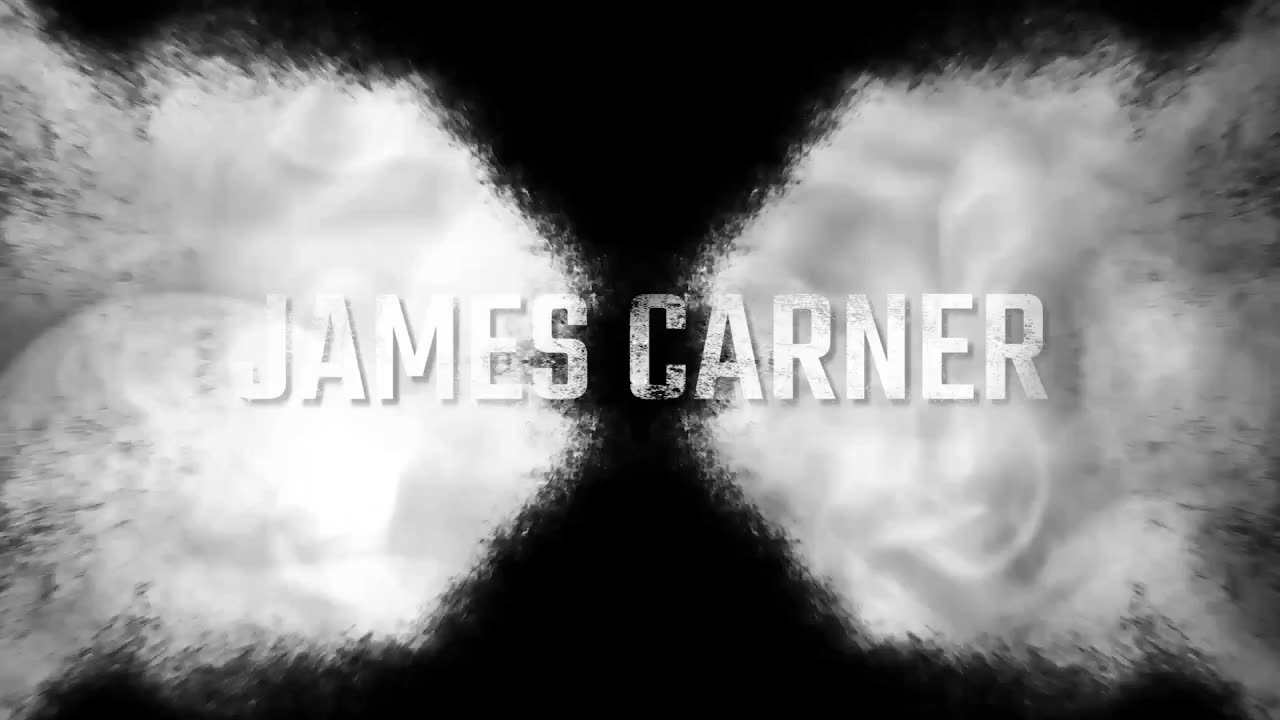Premium Only Content

The Sonic War: Sound as Creation, Control, and Sorcery
Cause Before Symptom - With Your Host James Carner
The Sonic War: Sound as Creation, Control, and Sorcery
Monologue: The Sonic War: Sound as Creation, Control, and Sorcery
Before there was light, before there was form, before the stars were set in their courses, there was sound. The universe was born not from silence but from speech—“And God said, Let there be light.” From that first utterance, reality itself has always been shaped by vibration. Sound is not decoration. Sound is not background. Sound is the operating system of creation. The breath of God carried the Word, and the Word became life.
But what God created as holy, the enemy has sought to corrupt. For if reality is shaped by sound, then to control sound is to control perception, emotion, even matter itself. This is the hidden war that has raged from Babel to Babylon, from the temples of Egypt to the laboratories of modern science. It is a war of sound—creation, control, and sorcery.
In Scripture, sound is everywhere. The walls of Jericho fell not by stone but by trumpet. David drove away tormenting spirits not with sword but with harp. The prophets cried aloud, their voices carrying God’s will into history. And at the end of the age, the heavens themselves will roar as seven trumpets declare judgment. Sound begins the story, and sound ends it
Yet alongside this holy witness is the counterfeit. The tower of Babel was more than bricks; it was a unity of tongues, a frequency engineered to pierce heaven without God. Ancient temples were built with acoustics designed to alter consciousness. Mystery schools whispered incantations in secret tones. Empires used chants and bells not only to call the faithful but to bind them in ritual control. Even today, frequencies are chosen not at random but with intent—music tuned to resonate with rebellion, weapons designed to shake the body with fear, broadcasts meant to lull the mind into submission.
We live in a world saturated with sound, yet starved of silence. Every store, every screen, every car is filled with frequencies—some obvious, some hidden—that shape our thoughts and emotions. Science calls it resonance. Sorcery calls it incantation. Scripture calls it the power of the tongue, life and death in speech. Whether in the hands of prophets or sorcerers, sound is never neutral.
And this is where we stand now: in the midst of a sonic war. God still speaks. His sheep still hear His voice. But the enemy floods the air with counterfeit frequencies, drowning out the still, small voice of the Spirit. What began with “Let there be light” will end with the trumpets of Revelation, when God Himself silences the sorcery of sound and restores creation to harmony.
Until then, we must understand this war. We must expose how sound is being used to control minds, stir fear, and open portals to darkness. We must reclaim sound as creation, worship, and life. And we must remember that in the end, the victory will not come by sword or machine, but by Word. For the same voice that spoke in the beginning will speak again, and when He does, every counterfeit frequency will shatter, and every lie will fall silent.
Part 1: The Word That Built the World
“In the beginning God created the heaven and the earth. And God said, Let there be light.” These are the first vibrations of history, the opening chords of the universe. Creation did not begin with the strike of a hammer or the flash of a sword, but with sound—with a word. That simple phrase, “And God said,” appears again and again in Genesis 1, like a rhythm, like a heartbeat. God spoke, and matter obeyed. God declared, and form appeared. The universe is not built on silence—it is built on speech.
The Gospel of John pulls back the veil on this mystery: “In the beginning was the Word, and the Word was with God, and the Word was God.” The Greek word here is Logos—but Logos does not simply mean “word” in the way we think of it. It means reason, order, vibration, the logic of the cosmos. It is not mere syllables—it is the living frequency of creation itself. John is telling us that the same Word that spoke light into existence became flesh and walked among us in Christ. The voice of creation was not an abstract force—it was a person.
The Hebrew Scriptures deepen this picture. The word for “spirit” is ruach, which also means breath or wind. The breath of God carried His word, and that word carried His power. Every time God breathed out speech, creation shifted. The psalmist says, “By the word of the Lord were the heavens made, and all the host of them by the breath of his mouth” (Psalm 33:6). In Geʽez, the ancient language of Ethiopia, the word for spirit also carries this sense of breath and vibration, showing that even in translation, the connection between voice, breath, and creation has always been known.
Science today is only beginning to glimpse what Scripture declared from the start. Physicists speak of the universe as vibration, string theory suggesting that everything is built on oscillating frequencies. The entire material world hums with energy, like instruments in a vast orchestra. What they describe in mathematical equations, Genesis described in sacred poetry: the universe exists because God spoke.
This is not metaphor. Sound has power. Words change the atmosphere. The tongue, as James says, is a small member, yet it steers the whole body. Death and life are in the power of the tongue. If this is true of our words, how much more the words of God? The universe is calibrated to His frequency. His word does not return void but accomplishes what He pleases. Creation itself listens and responds when He speaks.
But here is the danger: if reality is built on sound, then sound can also be hijacked. The enemy cannot create, but he can distort. If God’s Word is the true frequency, then sorcery is counterfeit vibration. This is why incantations, chants, and mantras are so central to occult practice. The fallen know that sound shapes reality, so they mimic the Creator’s method with corrupted tones. From the very beginning, the war of creation has been a war of sound—the true Word versus the counterfeit voice.
To understand the sonic war, we must start here: with the Word that built the world. Every vibration since has been an echo of that first command, “Let there be light.” And every counterfeit since has been an attempt to drown out that voice. The battle lines were drawn in Genesis 1, and they will be settled at the end, when the Word Himself returns, riding on the sound of heaven, speaking a sword that no sorcery can withstand.
Part 2: The Four Winds and the Breath of Prophets
If creation began with sound, then God’s prophets carried that same power through their voices. They did not merely think the will of God, they spoke it. They declared it into the air, knowing that the breath of man, aligned with the Spirit of God, could shift the course of history. The prophets understood what our modern world has forgotten—that breath and sound are not incidental, but instruments in the hand of God.
Nowhere is this clearer than in Ezekiel’s vision of the valley of dry bones. The prophet is taken by the Spirit and shown a plain filled with skeletons, lifeless remains of an army long dead. God asks him, “Son of man, can these bones live?” Ezekiel does not answer yes or no. He says, “O Lord God, thou knowest.” And then God commands him not to build, not to fight, not to write—but to prophesy. “Prophesy upon these bones, and say unto them, O ye dry bones, hear the word of the Lord.”
Ezekiel opens his mouth, breathes out words, and suddenly the bones rattle. Flesh covers them. Yet they are still lifeless. Then God commands him again: “Prophesy unto the wind, prophesy, son of man, and say to the wind, Thus saith the Lord God: Come from the four winds, O breath, and breathe upon these slain, that they may live.” And as Ezekiel speaks, breath enters them. They stand up, a great army, alive once more.
Notice what is happening here. The word and the breath are not symbolic—they are causal. Ezekiel’s voice becomes a conduit for the Spirit’s wind. His speech calls the four winds, and the winds carry the breath of God into the dead. Creation responds to sound when it is aligned with the Creator. What began in Genesis continues in the mouth of the prophet.
The “four winds” here are not just poetic. In the ancient world, winds were seen as carriers of spirit, as forces that encircle the earth. To summon the four winds is to call on the full vibration of creation, the resonance of the north, south, east, and west, converging into life. Ezekiel is shown that resurrection itself comes through breath—through sound—through the command of God spoken into the air.
This pattern runs throughout Scripture. Moses stretches out his staff, but it is his declaration that unleashes the plagues. Elijah calls down fire not by thought but by voice. Jonah’s preaching shakes Nineveh to repentance. John the Baptist’s cry in the wilderness prepares the way of the Lord. In every case, the prophet’s breath carries the vibration of heaven into earth.
Even in worship, Israel understood this truth. Psalms were not read silently—they were sung aloud. Trumpets were blown, cymbals clashed, voices cried. Their worship was sonic warfare, a declaration into the atmosphere that God reigns. When David played his harp before Saul, the tormenting spirit fled—not because of melody alone, but because sound aligned with God drives out darkness.
The Ethiopian Church still carries this ancient understanding. Their liturgy is not quiet ritual but a chant, a vibration that fills their stone churches until the very walls hum with sound. The priests sway, the drums beat, the sistrum rattles, and the chants rise in Geʽez, a language untouched by empire. To outsiders, it may seem repetitive or strange. But to Ethiopia, it is participation in the cosmic symphony—a joining of human breath with the breath of God.
What does this mean for us today? It means that prophecy is not abstract. It is not the silent thoughts of the heart. It is the sound of God’s will declared through human breath. It means that silence in the Church is surrender, while the voice of the saints is a weapon. And it means that the enemy, knowing this, has worked tirelessly to corrupt our breath—to fill our mouths with curses instead of blessing, lies instead of truth, noise instead of worship.
Ezekiel shows us the secret: resurrection comes when the breath of man aligns with the breath of God. The four winds still blow. The Spirit still speaks. And when God’s people open their mouths, dry bones still rise. This is why the sonic war matters—because the same instrument that can summon life can also summon death, depending on whose frequency we carry.
Part 3: Ancient Sound Mysteries
If God created the world through His voice and empowered His prophets through sound, then it is no surprise that the nations—both guided and deceived—sought to harness the same principle. The ancient world is filled with testimonies that sound was never considered mere background, but sacred, dangerous, transformative. Every civilization built systems around vibration, and though some caught glimmers of truth, many twisted them into sorcery. These are the ancient sound mysteries, fragments of the Creator’s design scattered and distorted among the nations.
In the East, Hindu tradition preserves the syllable AUM—the primordial sound said to underlie all creation. According to their teaching, everything in existence vibrates with this resonance. Chanting it is not just prayer but participation in the cosmic hum. Buddhists, too, repeat mantras endlessly, not for melody but for vibration, believing that the frequency itself shapes consciousness. In both cases, sound is understood as a bridge between the seen and the unseen, a doorway into altered states.
The Egyptians built temples whose very stones were tuned to resonate. Archaeologists have noted that in certain chambers, a single chant will set the walls trembling, amplifying the human voice until it feels as though heaven itself answers. Priests used these acoustics in rituals, believing that sound could carry the soul into contact with gods. And perhaps it did—not with the God of heaven, but with the fallen beings who masqueraded as deities, eager to feed on human devotion.
The Greeks spoke of the “music of the spheres,” an idea championed by Pythagoras, who claimed that the planets themselves emit vibrations as they move through the heavens, forming a cosmic harmony. To him, mathematics and music were not separate disciplines but one—the measurement of vibration. His followers believed that by understanding these harmonies, man could align himself with the divine order. What they glimpsed was true: creation does sing. The stars do resound. Scripture itself says, “The morning stars sang together, and all the sons of God shouted for joy” (Job 38:7). But in the hands of philosophers divorced from revelation, this truth became abstract, detached from the living God, ripe for occult appropriation.
Even in Israel’s neighbors, sound played a role in worship. Babylonian incantations, Canaanite chants, Druidic songs—all used repetition, rhythm, and tone to summon power. Demons do not invent—they imitate. They know that vibration can open doors. So they twist it, attach their names to it, and demand worship through it. Where the prophets of God declared truth with their voices, the prophets of Baal cut themselves and cried aloud, hoping their frenzy of sound would stir their god. Sound was their weapon too, but divorced from the Creator, it became bondage rather than life.
What unites all these ancient sound mysteries is the recognition that sound changes reality. Temples echoed with chants, caves with hymns, altars with cries. From India to Egypt to Greece, sound was seen as a key that could unlock the invisible world. But without God’s Spirit, that key opened the wrong doors. Instead of summoning the breath of life, it summoned the counterfeit. Instead of creation, it birthed confusion.
And yet we must not dismiss these traditions entirely. For even in their distortions, they bear witness to a hidden truth—that sound is primal. That frequency undergirds existence. That when man raises his voice, he participates in forces greater than himself. The question has never been whether sound has power. The question is which power it serves.
This is why the Bible warns of strange fire, of forbidden incantations, of sorceries. Because sound—like fire—is potent. In the hands of the righteous, it is worship and prophecy. In the hands of the wicked, it is sorcery and control. The ancients knew this, though they often chose wrongly. And the fallen angels, who once heard the harmonies of heaven, taught humanity to twist them into chains.
The ancient sound mysteries are not relics of primitive superstition. They are fragments of the original design, stolen, corrupted, and weaponized. And just as God scattered the tongues at Babel, He scattered these practices, breaking the counterfeit frequency so it could not fully usurp creation. But in every age, the enemy has tried again, using sound as his counterfeit ladder to heaven.
Part 4: Babel and the Counterfeit Frequency
The story of Babel is often told as a tale of human pride and architecture—a tower of bricks reaching toward the sky. But beneath the surface lies a deeper mystery. Babel was not just about height; it was about frequency. It was not only an attempt to build a structure, but to unify a sound. Humanity sought to create one voice, one vibration, one resonance powerful enough to pierce the heavens without God. And that is why God intervened—not because He feared masonry, but because He discerned the danger of a counterfeit frequency.
Genesis 11 tells us, “The whole earth was of one language, and of one speech.” The Hebrew suggests more than just shared vocabulary—it implies unity of utterance, a harmony of vibration. When men gathered on the plain of Shinar, they were not only pooling resources; they were pooling resonance. They believed that if their voices remained united, nothing would be restrained from them. In other words, frequency itself could become a ladder to heaven.
The tower was the visible symbol of this hidden project. Its bricks rose upward, but its power lay in the sound of many voices declaring the same thing at the same time. We must remember: heaven is not reached by technology, but by covenant. Yet here, men attempted to bypass covenant with vibration. The tower was a sonic temple, a counterfeit version of what Ezekiel saw when the breath of prophecy raised the dead. Babel was humanity trying to engineer resurrection without God.
This is why God’s judgment was so specific. He did not strike them with fire. He did not collapse the tower with an earthquake. He scattered their tongues. He fractured their frequency. In one moment, the unified resonance dissolved into confusion. The project collapsed not because the structure was weak, but because the sound was broken. God saw the danger of one counterfeit frequency dominating creation, and He shattered it before it could be completed.
But the spirit of Babel never died. It reappears in every empire that seeks to impose one voice, one language, one ritual chant upon the world. Babylon used hymns to Marduk. Rome used Latin chants. The medieval church enforced Gregorian tones. Modern governments use national anthems, pledges, and propaganda broadcasts. Each is a faint echo of Babel—the attempt to unify humanity under one vibration without God.
And this is not only political—it is spiritual. The Book of Revelation calls the end-time world system “Mystery Babylon,” mother of harlots. It is Babel reborn, not with bricks but with frequencies, not with clay but with waves. In our age, the counterfeit frequency is digital. The voices of billions are being unified through algorithms, tuned into one song of distraction and control. What Babel attempted with speech, modern Babylon attempts with media. The resonance is artificial, but the goal is the same: one frequency to dominate all.
Babel shows us the essence of the sonic war. Sound can build, but sound can also deceive. God scattered Babel to protect creation from a counterfeit harmony. But the enemy has never stopped trying to rebuild it. Every empire’s propaganda, every false religion’s chant, every weaponized frequency is another brick in the tower. And Revelation tells us that in the last days, Babylon will rise again, intoxicated by her own voice, confident that her song can pierce heaven itself.
But just as before, God will intervene. The trumpets of Revelation are His answer to the counterfeit frequency. Just as He scattered tongues in Genesis, He will shatter Babylon’s sound in the end. The tower of frequencies will fall, and the voice of the Lamb will silence the counterfeit song forever.
Babel is not just history—it is prophecy. It is the reminder that unity without God is not strength but sorcery, not harmony but hubris. And it is the warning that sound, when twisted, can become the deadliest weapon of all.
Part 5: Israel’s Sonic Warfare
If Babel shows us how sound can be twisted into counterfeit power, the history of Israel shows us how sound, when yielded to God, becomes a weapon of deliverance. From trumpets to harps, from battle cries to prophetic declarations, Israel’s story is filled with moments where victory came not by sword, but by sound. These are not myths or exaggerations. They are reminders that in the hands of the righteous, frequency is a force of heaven.
Consider Jericho. Israel did not bring down its walls with battering rams or siege engines. God gave Joshua a strange command: march around the city once a day for six days, with priests carrying trumpets of rams’ horns. On the seventh day, march seven times, then blow the trumpets and shout with one great voice. It was sound—not stone—that toppled Jericho. The unified blast of trumpets and the shout of a nation aligned with God shook the foundations until the walls collapsed. The victory was not theirs, but the Lord’s, carried through their breath.
Or take Gideon’s three hundred. Outnumbered beyond measure, they carried not swords into the night, but trumpets and clay jars with torches inside. At the signal, they broke the jars, lifted the torches, and blew their trumpets. The sound filled the camp of Midian like thunder, and confusion spread among the enemy until they turned on each other. Once again, sound carried the victory, not steel.
Even in the courts of Saul, we see the same truth. The king was tormented by an evil spirit, restless and raging. But when David took up his harp and played, the spirit fled. Not because of David’s skill alone, but because the sound of worship carries authority demons cannot withstand. Darkness trembles at holy sound, just as walls tremble at prophetic trumpets.
Israel’s worship itself was designed as sonic warfare. Psalms were not whispered—they were sung aloud, accompanied by cymbals, harps, trumpets, and shouts of joy. Their feasts resounded with music. Their priests blew shofars to mark holy days and to warn of danger. Sound was not an accessory to worship—it was the essence of it. In declaring God’s glory with their voices, Israel was not just expressing devotion—they were aligning with the very frequency of creation.
This is why the shofar remains so significant. Its blast is not a melody but a vibration, primal and raw, echoing through the air like thunder. When the shofar sounds, it pierces the atmosphere, stirring memory, warning of judgment, calling to repentance. It is not merely tradition—it is technology of the Spirit, designed to shake both earth and heaven.
The prophets also wielded sound as weapon. Elijah called out the prophets of Baal, and when he prayed aloud, fire fell from heaven. Isaiah cried, “Cry aloud, spare not, lift up thy voice like a trumpet, and show my people their transgression.” Jeremiah wept aloud with laments that still echo today. Their voices carried judgment and mercy alike, shaping nations by the vibration of words.
In every case, the lesson is the same: when sound is aligned with God, it carries more force than armies. It topples walls, scatters enemies, drives out demons, and awakens the dead. Sound is the breath of God amplified through human obedience.
This is why the enemy has always tried to counterfeit it. For if a single shout can topple Jericho, then a counterfeit shout can build Babel. If David’s harp can drive away demons, then corrupted music can summon them. If Israel’s worship can fill the temple with God’s glory, then corrupted sound can fill temples of idols with darkness. The war of sound is not a side issue—it is the battlefield itself.
Israel’s story reminds us that we do not wage war only with weapons of flesh, but with the sound of our mouths, the breath of our lungs, the declarations of our faith. And it foreshadows the last days, when once again sound—not armies—will determine the outcome. For in Revelation, it is the trumpets of heaven that shake the earth, and the shout of the returning King that silences every enemy.
Part 6: Rome, Ritual, and Sorcery of Sound
If Israel’s story reveals how sound can be weaponized for God’s purposes, Rome reveals how sound can be twisted into chains of control. From the days of the Caesars to the halls of the Vatican, empires have understood that sound does not merely move the heart—it bends the will. And where God used trumpets to tear down walls, Rome used chants, bells, and ritual incantations to build invisible prisons. This is the sorcery of sound, sanctified in marble, enforced by empire.
The Roman Empire itself was never ignorant of sound. Its arenas thundered with chants, its legions marched to drums, its emperors were greeted with acclamations that shook the stones of the Forum. Sound unified the masses, embedding loyalty into their very bodies. When the people roared, “Caesar is lord,” the air itself reinforced empire’s lie. Rome discovered that to rule the voice was to rule the people.
When Christianity became entangled with Rome, the manipulation of sound deepened. The early church had been filled with spontaneous psalms and prophetic songs. But under Rome’s authority, worship became regulated, controlled, systematized. By the sixth century, Gregorian chant was introduced—not by the Spirit’s fire but by papal decree. These chants, beautiful to the ear, were also designed with specific tonal patterns that subdued the soul. They were repetitive, hypnotic, lulling worshipers into passivity. Sound was no longer warfare—it was sedation.
The Vatican added another layer: bells. Church bells marked every hour, structuring daily life around the rhythms of Rome’s religion. The tolling of bells was not merely practical—it was psychological, embedding obedience through sound. From cradle to grave, the chime of bells told men when to rise, when to work, when to pray, when to mourn. The people no longer followed the Spirit’s leading—they followed the sound of Rome.
Incantation also became central. Latin liturgies, spoken in tones the common man could not understand, filled cathedrals with vibration. But the words were foreign, the meaning hidden, the power centralized in the priest alone. The people were bathed in sound, but starved of truth. This is the sorcery of empire: not to silence, but to control the frequency.
The esoteric schools of Rome knew this well. The Jesuits studied acoustics in their seminaries. Temples and cathedrals were built with intentional echoes, designed so the priest’s voice would carry like thunder, while the congregation’s murmurs would be swallowed. Architecture became an amplifier of hierarchy, embedding the idea that only the voice of Rome reached heaven.
Beyond the church, secret societies carried on sound rituals in darker forms. Masonic lodges used chants and oaths. Mystery cults invoked spirits through monotone repetition. The occult has always known that the right frequency, spoken in unity, can open doors. And Rome, with its long history of syncretism, borrowed liberally from these traditions, weaving them into its rituals while baptizing them with Christian names.
But perhaps the greatest sorcery of sound Rome achieved was silence. The silence of the laity, forbidden to speak in worship, forbidden to sing in their own tongue, forbidden to prophesy aloud. The congregation became passive listeners while the priest alone spoke. In Israel, the people shouted, sang, and declared. In Rome, the people knelt, hushed, and obeyed. This was not worship—it was programming.
And yet, even in its beauty, there is danger. Gregorian chant resonates with haunting harmonies. Cathedrals echo with awe. The bells toll with majesty. But beauty does not always mean truth. Sorcery is often clothed in splendor. Rome learned that if you control the soundscape of a people, you control their souls.
This is why the Reformation, for all its flaws, restored congregational singing. Luther knew that hymns in the common tongue were weapons against Rome’s silence. And this is why today, controlling the soundscape of media, music, and worship remains the enemy’s priority. The war of sound did not end with Israel’s trumpets—it continues through Rome’s chants, into our own age.
Rome’s story shows us that sound, once weaponized for heaven, can be hijacked for hell. It shows us that ritual, when stripped of Spirit, becomes sorcery. And it warns us that the battle for frequency is not just waged in laboratories or battlefields, but in cathedrals, sanctuaries, and the very voices of those who claim to worship God.
Part 7: Modern Frequency Manipulation
What Rome cloaked in ritual and chant, the modern world has recast in the language of science. But beneath the laboratory coats and mathematical formulas lies the same ancient truth: sound shapes reality. Modern frequency research does not discover anything new—it rediscovers what prophets, priests, and sorcerers have always known. Only now, stripped of sacred context, these truths are weaponized for control.
The science of resonance is one of the clearest examples. Every object, from a wine glass to a skyscraper, has a natural frequency—a pitch at which it vibrates most strongly. Strike the right note, and the object begins to hum. Push it further, and it can shatter. Sound is not decoration—it is force. The same principle that toppled Jericho is now used in engineering, medicine, and, yes, weaponry.
Cymatics—the study of visible sound—makes this even clearer. Sprinkle sand or water on a vibrating plate, and patterns appear. Geometric shapes, intricate mandalas, shifting forms—all created by nothing more than frequency. Matter itself arranges in response to sound. What Genesis declared, cymatics demonstrates: the Word shapes reality. Yet instead of glorifying the Creator, the world marvels at patterns while ignoring the voice behind them.
The Schumann resonance offers another window. The earth itself hums at a natural frequency—about 7.83 hertz. This “heartbeat of the planet” aligns closely with human brainwaves. When we are calm, at rest, or in deep meditation, our brains often vibrate in harmony with the earth. Ancient mystics may not have measured it, but they sensed it. They knew caves, temples, and mountains amplified this resonance. To dwell there was to tune one’s spirit to the hum of creation. But in our age of artificial frequencies—cell towers, Wi-Fi, 5G—the natural resonance is drowned. Humanity is disconnected from the earth’s rhythm and bombarded with alien vibrations.
Even music itself has been tampered with. For centuries, instruments were tuned to natural resonances—most notably 432 hertz, a frequency many believe aligns more harmoniously with creation. But in the twentieth century, a shift occurred. The international standard was set at 440 hertz. On the surface, it was a minor change—eight tiny vibrations per second. But beneath the surface, it altered the way music interacts with the body. Some researchers argue that 440 hertz produces tension and agitation, while 432 hertz promotes calm and clarity. Whether or not every claim holds, the symbolism is undeniable: even the tuning of instruments became a battlefield in the sonic war.
Governments and militaries quickly recognized the potential. Infrasound—frequencies below the range of human hearing—can induce anxiety, nausea, even hallucinations. Sonic weapons mounted on vehicles disperse crowds not with bullets, but with unbearable sound waves. Ultrasound is used to break apart kidney stones in hospitals, proving that sound can penetrate and disrupt the body itself. The same principle can be weaponized against flesh in darker ways.
Corporations, too, manipulate frequencies for profit. Shopping malls and fast-food chains design soundscapes to slow you down or speed you up, to loosen your wallet without your awareness. Music is engineered not only for rhythm but for resonance, exploiting the brain’s susceptibility to vibration. Algorithms now curate playlists not to nourish the soul but to mold behavior. Sound has become commerce, engineered control.
But here is the deeper point: modern science, stripped of reverence, is repeating Babel’s project. It is seeking to manipulate vibration without the Creator. It measures the hum of the earth, but ignores the Word that sustains it. It maps resonance, but wields it for power rather than worship. It discovers that sound shapes matter, but uses that truth to sell products or scatter crowds instead of to declare life.
The manipulation of frequency is no longer the secret of priests or sorcerers—it is the agenda of governments, corporations, and global elites. The very air around us hums with their counterfeit symphony. And while they claim it is progress, Scripture warns us that the last days will be filled with sorcery. The Greek word in Revelation is pharmakeia—often translated as drugs, but it also encompasses enchantment, manipulation, unseen influence. Frequency manipulation is modern sorcery, cloaked in science.
The prophets once commanded the four winds. Now the elites command the airwaves. And the question is not whether sound has power, but whether we recognize whose frequency we are living under. For the sonic war has moved from temples and towers into the very atmosphere of modern life.
Part 8: The Hidden War of Frequencies
If sound is the operating system of creation, then whoever controls frequency controls reality itself. This is the battlefield the elites understand and the church too often ignores. For while we debate politics and headlines, a hidden war rages in the very air around us—a war of frequencies designed to mold thought, stir fear, and enslave souls without a single shot fired.
This war has been studied in secret for decades. Governments have poured billions into understanding how sound alters the mind. During the Cold War, both East and West experimented with sonic influence. Declassified documents reveal tests with infrasound—low-frequency waves that cannot be heard but can be felt. These waves induce unease, anxiety, and even terror. Soldiers exposed to them reported panic without cause, dread without reason. The enemy learned that fear could be broadcast, not spoken.
Mind control programs like MK-Ultra did not stop at chemicals. Researchers explored how tones, pulses, and rhythmic sounds could weaken defenses and open consciousness to suggestion. White noise, binaural beats, and low-frequency oscillations became tools not only for relaxation, but for manipulation. What once was chanted in temples is now pulsed through headphones, labs, and even weapon systems.
Consider crowd control. Today, police and militaries deploy LRADs—Long Range Acoustic Devices—that blast concentrated sound waves into protesters. These devices do not kill, but they scatter. The sound pierces the ears, rattles the bones, and overwhelms the nervous system until the crowd disperses in agony. No bullets, no blood—just sound. A weapon as invisible as it is undeniable.
And the war is not confined to battlefields. In our daily lives, frequencies bombard us constantly. The hum of fluorescent lights, the buzz of cell towers, the pulse of Wi-Fi routers, the drone of appliances—all fill the soundscape with vibrations we cannot see. Some resonate with the body; others disrupt its natural rhythms. Studies link constant exposure to artificial frequencies with insomnia, anxiety, and depression. The human spirit was made to resonate with creation’s hum, but instead we are bathed in static.
Even music itself has been weaponized. Popular songs are engineered not only for rhythm but for trance. Repetition, bass frequencies, and subliminal tones create states of altered consciousness. Lyrics ride on these vibrations, embedding messages beneath the surface. What once was worship through psalms has become indoctrination through playlists. The enemy knows that if he controls the soundtrack of a generation, he controls its spirit.
This hidden war of frequencies is Babel reborn. A unified resonance, not through shared tongue, but through engineered sound. It is not the people declaring one voice, but machines broadcasting one vibration. And it is global. Everywhere you go, from airports to grocery stores to living rooms, the atmosphere is filled with frequencies designed to control mood, thought, and action. The world hums with invisible commands.
Scripture warned us this would come. In Revelation, Babylon is described as intoxicating the nations, making them drunk with her sorceries. Sorcery is not always potions—it is influence, manipulation, enchantment. What better enchantment than sound itself, humming beneath perception, shaping hearts without consent? The nations are drunk on frequencies they cannot name, lulled into submission by vibrations that bypass reason.
But here is the hope: just as in Ezekiel’s vision, the four winds still belong to God. Just as in Jericho, trumpets still fall walls. Just as in Revelation, the trumpets of heaven will still shake the earth. The hidden war of frequencies is real, but it is not final. The enemy may control the static, but he cannot silence the Shepherd’s voice. And when the final trumpet sounds, every counterfeit resonance will collapse into silence.
The question for us is whether we will remain unaware, lulled by the hum of Babylon, or whether we will tune our spirits to the true frequency—the Word of God, sharper than any sword, stronger than any broadcast. For the hidden war of frequencies is not won by volume, but by discernment. Those who know His voice will not be deceived, no matter how loud the static becomes.
Part 9: Sorcery of Music and Media
If the hidden war of frequencies surrounds us in the air, then its sharpest spear pierces through what we call entertainment. Music, film, television, even the background noise of digital life—these are not neutral. They are carefully engineered soundscapes, designed to bypass thought, stir emotion, and open the soul. What Israel once used as worship, what prophets once wielded as weapon, the enemy has twisted into sorcery. Today’s media is not only entertainment—it is ritual.
From the beginning, music was sacred. The first instruments in Genesis came from Jubal, “the father of all who handle the harp and organ.” In Israel, psalms and harps carried worship into the heavens. David’s songs still echo as Scripture, marrying sound to Spirit. But Satan himself, described in Ezekiel as a being adorned with timbrels and pipes, has always been tied to music. If he fell with instruments in his being, then he knows the power of sound better than any human. And in every age, he has used music to corrupt what God gave as holy.
Modern music is the clearest example. Songs are not only crafted for melody but for trance. Repetition hypnotizes. Bass frequencies, pulsing below conscious hearing, stir the body into rhythmic submission. Lyrics ride on these waves, embedding messages of rebellion, lust, despair, and rage directly into the soul. Concerts amplify this to mass ritual—tens of thousands moving as one, chanting in unison, lights flashing in sync with beats. What once happened in temples of Baal now happens in stadiums, broadcast across the world.
Film and television join the chorus. Every soundtrack is engineered to tell you how to feel—tense, joyful, broken, triumphant. Horror movies use infrasound to trigger dread before a monster even appears on screen. Action movies raise heart rates with rapid beats. Even advertisements use jingles that burrow into memory, looping until obedience becomes instinct. The image captures the eyes, but the sound captures the spirit.
Digital media adds another layer. Video games, apps, even social media notifications—all are sonically tuned. The ping of a message, the chime of a like, the swoosh of a send—these tiny frequencies create dopamine spikes, training brains like Pavlov’s dogs. Humanity no longer listens to silence. Every moment is scored by tones designed to bind attention. What looks harmless is in fact ritualized conditioning, a liturgy of distraction.
And beneath it all lies intention. Elites and artists alike often admit their allegiance. How many musicians speak openly of selling their soul, of voices that give them songs, of rituals before shows? How many films glorify the occult, pairing images of sorcery with music that enthralls? Even children’s shows hum with suggestive tones, training the young to resonate with rebellion. This is not accident—it is sorcery with speakers.
The ancients chanted to summon spirits. Today, playlists do the same. The ancients built temples with acoustics. Today, we build headphones and surround sound. The ancients repeated mantras. Today, choruses loop endlessly on pop radio. The form has changed, but the essence is the same. Sound as gateway, sound as control, sound as sacrifice.
This is why Scripture warns us to “sing unto the Lord a new song.” Worship is not entertainment—it is warfare. And this is why Paul tells us to speak to one another in psalms and hymns and spiritual songs. God knows that sound fills the soul. The only question is: with what?
The sorcery of music and media is the enemy’s attempt to flood the world with counterfeit frequencies so loud that the still, small voice of the Spirit is drowned out. It is Babel with earbuds. It is Babylon with a soundtrack. And unless we discern it, we will mistake ritual for recreation.
But the truth remains: the enemy cannot create, only distort. Music still belongs to God. Sound still belongs to heaven. And in the last days, the saints will overcome not with silence but with song—“They sang the song of Moses and the song of the Lamb” (Revelation 15:3). That song will shatter every counterfeit, for when God’s people worship, no sorcery can stand.
Part 10: The Coming Sonic Showdown
Every battle in history has prepared for this—the last and greatest clash of sound. What began in Genesis with “And God said” will end in Revelation with the trumpets of heaven and the shout of the returning King. The sonic war is not a side note in prophecy—it is the battlefield on which the end of the age will be decided. And Scripture is clear: sound, not silence, will mark the final hour.
Revelation tells us of seven trumpets, each releasing a wave of judgment upon the earth. Hail and fire, burning mountains, poisoned waters, darkened skies—each blast is not only a symbol but a frequency that shakes creation itself. Just as Jericho’s walls fell to trumpet blasts, so the walls of Babylon will fall to the sound of heaven. Trumpets are not metaphors—they are frequencies of divine authority, resonating through creation until every counterfeit resonance collapses.
But the trumpets are not the only sound. Revelation also speaks of the voices of martyrs crying beneath the altar, the song of the 144,000 singing a new song no one else can learn, the roar of many waters like the voice of Christ Himself. Heaven is not silent in the end—it resounds. Every false frequency, every counterfeit chant, every engineered hum will be drowned in the flood of divine sound.
The enemy knows this, which is why he prepares his own showdown. His music saturates the air. His frequencies agitate the body. His media loops like liturgy, training souls to resonate with rebellion. Mystery Babylon intoxicates the nations with her song, just as Nebuchadnezzar demanded all bow to the sound of his instruments before the golden image. The Antichrist will do the same. His kingdom will not rise in silence but in sound—a frequency designed to unify the world in worship of the beast.
Yet the final word belongs not to him but to Christ. Paul writes that the Lord will descend with a shout, with the voice of the archangel, and with the trumpet of God. That shout will pierce every frequency. That voice will silence every lie. That trumpet will call the dead from their graves and the living into glory. The sonic war will end with a single frequency—the Word of God, spoken once more, as it was in the beginning.
This is why worship matters now. The songs we sing, the declarations we make, the voices we lift—they are rehearsals for the final showdown. When the world is drunk on Babylon’s music, the saints will still be singing the song of the Lamb. When the Antichrist fills the air with his frequency, the Spirit will still speak through the breath of God’s people. And when the trumpets of heaven sound, the counterfeit will be shattered forever.
The coming sonic showdown is not about which side is louder—it is about which side carries truth. The enemy’s sound is noise, empty and fleeting. God’s sound is creation, eternal and unstoppable. In the end, the war will not be decided by armies, weapons, or technology, but by a voice. One voice. The same voice that spoke light into being will speak again, and when He does, the war of sound will be over, and creation will be restored to harmony under its rightful King.
Conclusion: The Sonic War
From Genesis to Revelation, one truth resounds: sound is never neutral. It is the current of creation, the breath of prophets, the weapon of worship, and the language of both heaven and hell. God spoke, and the world was born. He will speak again, and the world will be remade. Between those bookends, every generation has been caught in the same struggle—the war of sound.
The ancients knew it. They chanted in temples, tuned their stones to resonance, and sought to pierce the veil with vibration. Babel tried to unify the world in one counterfeit frequency. Empires harnessed sound to enthrall, Rome cloaked it in chant, and the Vatican tolled bells to rule time itself. Science rediscovered it, speaking of resonance, cymatics, and planetary hums—then weaponized it through infrasound, LRADs, and the manipulation of media. Music became sorcery. Entertainment became ritual. The air itself became saturated with static designed to confuse, seduce, and enslave.
But in every age, God has answered. At Jericho, trumpets toppled walls. In Gideon’s night, shouts scattered armies. David’s harp drove out spirits. The prophets cried aloud and nations shifted. Worship shook temples with glory. And in the end, seven trumpets will roar, martyrs will sing, and Christ Himself will descend with a shout that silences every counterfeit.
The sonic war is not theory—it is reality. Every voice we hear, every song we choose, every frequency that fills our homes and hearts is part of this battle. Babylon floods the air with her sound, but the Shepherd still calls His sheep by name. The world is tuning itself to the beast, but the remnant is tuning itself to the Lamb.
The question is simple: whose frequency are we resonating with? The counterfeit hum of empire, or the eternal Word of God? For when the final showdown comes, it will not be won by weapons, but by sound. And when the voice of the Lord speaks once more, all other sounds will fall silent.
Creation began with a word. Creation will end with a word. The sonic war belongs to God—and in the end, His voice will be the only one left standing.
Bibliography
Ancient / Scriptural Sources
* The Holy Bible: Genesis 1; John 1; Ezekiel 37; Joshua 6; Judges 7; 1 Samuel 16; Psalms; Isaiah 18; Revelation 8–11, 14–15.
* The Ethiopian Orthodox Tewahedo Canon (Enoch, Jubilees, Ascension of Isaiah).
* The Book of Enoch. Trans. R.H. Charles. Oxford: Clarendon Press, 1912.
Historical / Esoteric Sources
* Budge, E.A. Wallis. Egyptian Magic. London: Kegan Paul, 1901.
* Godwin, Joscelyn. The Harmony of the Spheres: A Sourcebook of the Pythagorean Tradition in Music. Rochester: Inner Traditions, 1993.
* Schwaller de Lubicz, R.A. The Temple of Man. Rochester: Inner Traditions, 1998.
* Yates, Frances A. The Rosicrucian Enlightenment. London: Routledge, 1972.
Scientific / Modern Sources
* Chladni, Ernst F.F. Discoveries in the Theory of Sound. Leipzig, 1787 (early cymatics).
* Jenny, Hans. Cymatics: A Study of Wave Phenomena and Vibration. Newmarket: Macromedia, 1967.
* Schumann, W.O. “Über die strahlungslosen Eigenschwingungen einer leitenden Kugel, die von einer Luftschicht und einer Ionosphärenhülle umgeben ist.” Zeitschrift für Naturforschung, 1952. (Schumann Resonance).
* Goodman, Steve. Sonic Warfare: Sound, Affect, and the Ecology of Fear. Cambridge: MIT Press, 2010.
* Attali, Jacques. Noise: The Political Economy of Music. Minneapolis: University of Minnesota Press, 1985.
* Revelations from declassified U.S. Army and CIA research into infrasound, LRADs, and MK-Ultra acoustic experiments (FOIA collections).
Scriptural Endnotes
1. Genesis 1:3 – “And God said, Let there be light.” Creation by sound.
2. John 1:1–3 – “In the beginning was the Word.” The Logos as frequency of creation.
3. Ezekiel 37:4–10 – The valley of dry bones revived by prophetic speech and the four winds.
4. Joshua 6:20 – Jericho’s walls fall at the sound of trumpets and a shout.
5. Judges 7:20–22 – Gideon’s three hundred blow trumpets and shatter jars, confusing Midian.
6. 1 Samuel 16:23 – David’s harp drives away the tormenting spirit from Saul.
7. Psalm 33:6 – “By the word of the LORD were the heavens made, and all the host of them by the breath of his mouth.”
8. Isaiah 18:1–7 – Prophecy of gifts brought from “a people scattered and peeled” (Cush/Ethiopia) to Mount Zion.
9. Revelation 8–11 – The seven trumpets of judgment.
10. Revelation 14:3; 15:3 – The new song of the 144,000 and the song of Moses and the Lamb.
11. 1 Thessalonians 4:16 – “The Lord himself shall descend from heaven with a shout, with the voice of the archangel, and with the trumpet of God.”
Historical and Esoteric Endnotes
1. Hindu Mandukya Upanishad – AUM as primal vibration of creation.
2. Pythagoras’ teaching of the “music of the spheres” as cosmic harmony (Godwin, 1993).
3. Egyptian temple acoustics designed for resonance, tied to ritual practice (Schwaller de Lubicz, 1998).
4. The Tower of Babel as a unified frequency project (Genesis 11). God’s scattering of tongues as fracturing of resonance.
5. Gregorian chant as systematized sonic control under Rome; Latin liturgy as incantation (Yates, 1972).
6. Jesuit studies of acoustics in cathedral design, amplifying the priest’s voice.
7. Change of musical tuning from A=432 Hz to A=440 Hz standard (early 20th century, codified by ISO in 1955).
8. Infrasound research: physiological and psychological effects (Jenny, 1967; Goodman, 2010).
9. LRAD (Long Range Acoustic Device) deployments for crowd control, U.S. military and police.
10. CIA’s MK-Ultra sub-projects exploring sonic influence on behavior (declassified FOIA files).
11. Commercial use of soundscapes in retail and advertising—“Muzak” studies, Attali (1985).
-
 2:09:24
2:09:24
Inverted World Live
6 hours agoRats Have Learned to Hunt Bats | Ep. 135
28.3K9 -
 2:48:01
2:48:01
TimcastIRL
7 hours agoLIVE Election Coverage: Polling Stations SWATTED, Bomb Threats Called In | Timcast IRL
245K173 -
 3:30:07
3:30:07
Barry Cunningham
7 hours agoBREAKING NEWS: COUNTDOWN TO COMMUNISM! ELECTION RESULTS SHOW!
54.7K41 -
 2:11:28
2:11:28
DeVory Darkins
6 hours agoLIVE NOW: 2025 Election results and Exit Polls AMA
65K43 -
 2:34:04
2:34:04
DLDAfterDark
5 hours ago $0.06 earnedJust Another Tuesday - In Virginia - The Governor's Race & Glock Talk
26K4 -
 3:21:38
3:21:38
The Charlie Kirk Show
8 hours agoJUDGMENT DAY 2025: The Election Results Stream
194K79 -
 3:51:07
3:51:07
MattMorseTV
9 hours ago $0.80 earned🔴Election Day LIVE COVERAGE.🔴
95.8K47 -
 1:16:51
1:16:51
Flyover Conservatives
1 day agoSHOCKING DATA REVEALS: Young Voters Are Done With the Old GOP - Mark Mitchell, Rasmussen Reports | FOC Show
40.5K17 -
 1:15:28
1:15:28
Sarah Westall
9 hours agoGrooming is Protected and Encouraged by the System – Michelle Peterson and Mike Adamovich
34.2K10 -
 4:00:13
4:00:13
Akademiks
6 hours agoKendrick tries to Flip the Bots on DRAKE? WHo Beats Jay z in a verzuz. Blueface finally free!
38.5K9